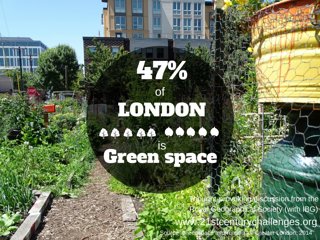What’s the challenge?
We are now very much an urban species. By 2050 three-quarters of the global population are expected to live in cities and globally we will be building the equivalent of a new city the size of Birmingham every week for the next 30 years. Such rapid urbanisation brings challenges, not just to the physical environment but also to quality of life and people’s subjective feelings of wellbeing, happiness and life satisfaction. As we learn more about people’s experiences of living in cities and urban spaces, how can we use this information to make cities around the world happier and more liveable?
Where do most people aspire to live? In developed countries like the UK, many city dwellers say they would prefer to be in the countryside. There is plenty of evidence to support the view that many people prefer a rural sense of place to an urban sense of place.
A new Mappiness survey shows that people feel happier when they are closer to nature. Successive UK Census survey results reveal that many people have migrated away from British cities towards rural areas. When asked why, counterurban migrants say that they have gone in search of an improved quality of life. Symptoms of urban stress, such as congestion and noise pollution, have pushed these people away. The first lesson in this teaching resource focuses on these issues.
When taking a global view, however, the future for the majority of people on the planet is projected to be an urban one. The most rapid wave of urbanisation ever seen is underway in developing countries and emerging economies (including Brazil, India, China, Mexico, Indonesia and Nigeria). Since the 50:50 milestone was passed in 2008, urban areas have become home to more than half the world’s population; by 2050 three-quarters of us are projected to be town and city dwellers. This forms the focus for the second lesson.
Managing change in a burgeoning number of global megacities and megaregions will not be easy. However, there are grounds for optimism:
-
New technology is being incorporated into smart cities and eco-cities
-
Compact urban living is allowing the world’s poorest people to gain access to vital services that are still unavailable in rural areas
-
Cities are associated with economic development and modernisation
-
‘Urbanists’ such as Leo Hollins take a philosophical viewpoint that ‘people are hard-wired to be together and this happens in cities’
This 2014 scheme of work has relevance for the study of all existing major A-level geography Specifications, as well as the International Baccalaureate diploma programme in geography.
The emphasis in this scheme of work on the key geographical concept of ‘place’ will support core teaching for the 2016 revised GCE A-levels in geography.

21st Century Challenges held a panel discussion on 26 June 2014 to discuss the issue.
Hear about this challenge from:
Rachel Cooper OBE, Professor of Design Management and Policy at the University of Lancaster and Director of Imagination Lancaster
Recent projects include: ‘Vivacity 2020’ Sustainable Urban Design for the 24 Hour City, (EPSRC funded 2003 -2008); Urban Futures, ( EPSRC funded 2008-2012). In 2008 she completed a state of the science review on the relationship between the physical environment and wellbeing for the UK Foresight programme ‘Mental Capital and wellbeing’. She is co-director of Highwire, Digital Economies Innovation Doctoral Training Centre (EPSRC £3m) at Lancaster University.
Currently Professor Cooper is running The Creative Exchange ( AHRC 2012 -2015) looking at the Digital Public Space and Knowledge Exchange, and is co-director of Liveable Cities. Professor Cooper has written extensively in the field, including the Handbook of Design Management (2013) and is currently commissioning editor for an Ashgate series on Socially Responsible Design. Her latest book ‘Wellbeing and the Physical Environment was published by Wiley Blackwell in January 2014.
Professor Cooper was President of the European Academy of Design 1995 – 2013, and founding Editor of The Design Journal (1997 -2014) and member of the EU Design and Innovation Leadership Board. She is currently a member of the Lead Expert Group advising the Foresight Programme on the Future of Cities, and is non-executive board member of the Future Cities Catapult. She was awarded an OBE in 2012 for Services to Education.
Jeremy Bentham, Vice President Global Business Environment, Royal Dutch Shell and Head of the Shell Scenarios team which has published a special Future Cities supplement in collaboration with the Centre for Liveable Cities, Singapore.
Jeremy has been in the energy business for more than 30 years. He is a graduate of Oxford University where he read physics. He joined Shell in 1980 following post-graduate experience at the California Institute of Technology. He also holds a masters degree in management from the Massachusetts Institute of Technology, where he was a Sloan Fellow from 1990 to 1991.
Following experience in both research and technology process design, Jeremy worked in the areas of manufacturing economics, industry analysis and commercial information technology. He then held line management positions coordinating commercial and production activities at a number of refinery facilities. Subsequently he became manager of corporate strategy analysis within the Corporate Centre of the Shell Group, and then led a strategic project for Shell’s Exploration and Production Business.
Jeremy joined the leadership team of Shell’s global commercial technology company, Shell Global Solutions in 1999, with specific responsibility for commercial and strategic developments including new business. He was subsequently appointed as chief executive of Shell Hydrogen. Since January 2006 he has been responsible for Shell’s Global Business Environment team, which is best known for developing forward-looking scenarios to support strategic thinking and direction-setting.
Dr George MacKerron lectures in environmental and behavioural economics at the University of Sussex, with affiliations to UCL and LSE.
His research covers topics including subjective wellbeing, environmental quality, spatial analysis and crowdsourcing.
Mappiness study, providing new and unique evidence on how our happiness is linked to our environment. He is also Chief Technology Officer for Psychological Technologies, a startup company developing apps for mindfulness and workplace wellbeing.
“We designed Mappiness to crowdsource data and help us understand the impact of a person’s immediate surroundings on their wellbeing, teaching us more about the geography of happiness,” Dr George MacKerron
“We have found that people are substantially happier in green and natural environments than they are in urban environments. This provides new evidence about the link between nature and wellbeing, and could ultimately provide new insights for policymakers.” Dr George MacKerron
Leo Hollis, writer, historian, urbanist
Leo was born in London in 1972, and studied history at university. He is the author of two books on the history of London: The Phoenix: The Men Who Made Modern London and The Stones of London: A History Through Twelve Buildings. He writes regularly for the New Statesman, the Times Literary Supplement and the Daily Telegraph.
In April 2013 he published CITIES ARE GOOD FOR YOU: The Genius of the Metropolis which has become an international bestseller. Described by Michael Sorkin as ‘an eloquent, nuanced, and learned account of the ways in which cities can serve as conduits for happiness. His wide-ranging and acute observations of the interaction of the social and the formal map an optimistic and incisive vision of an emergent – and indispensable – urbanism predicated on sustainability, equity, imagination and trust.’
His blog can be found at http://www.citiesaregoodforyou.com and he tweets at @leohollis.
“Cities seem to amplify the dangerous division between us,” he says. “But they also offer the best possibility for finding a solution. There is an overlooked power to urban life that can be found in the dense interweaving of everyday lives that make cities unique, and promises a more equitable, creative and sustainable future.”
Your questions
Q1 How can we encourage good design of urban spaces?
Q2 What can we do to improve the quality of life for people in rural areas?
Q3 How can we balance urbanisation with conserving the countryside?
Q4 Does Mappiness ask a range of questions and does it look at ethnicity and gender?
Q5 How can we get more funding for parks?
Q6 Is urbanity a property of people or place?
Q7 Is high density or low density living better for quality of life?
Q8 How does urban life affect mental health?
Q9 Can anything be done to make cities more affordable to live in?
Q10 How is population density affecting the social structure of cities?
Q11 Are mega cities inevitable and are they really a good thing?
Q12 Surprisingly, children in urban areas feel more connected to nature than children in rural areas. What do the panel think about this?
Further reading
Public space, Regan Koch for ‘Ask the experts’
How to save our town centres, Geographical Magazine
Sustainable Urbanism, Geography Directions
Happy city, book review, Geographical Magazine, February 2014
